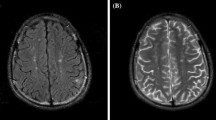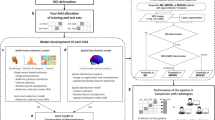Abstract
Objectives
To develop an MRI-based multi-lesion radiomics model for discrimination of relapsing-remitting multiple sclerosis (RRMS) and its mimicker neuropsychiatric systemic lupus erythematosus (NPSLE).
Methods
A total of 112 patients with RRMS (n = 63) or NPSLE (n = 49) were assigned to training and test sets with a ratio of 3:1. All lesions across the whole brain were manually segmented on T2-weighted fluid-attenuated inversion recovery images. For each single lesion, 371 radiomics features were extracted and trained using machine learning algorithms, producing Radiomics Index for Lesion (RIL) for each lesion and a single-lesion radiomics model. Then, for each subject, single lesions were assigned to one of two disease courts based on their distance to decision threshold, and a Radiomics Index for Subject (RIS) was calculated as the mean RIL value of lesions on the higher-weighted court. Accordingly, a subject-level discrimination model was constructed and compared with performances of two radiologists.
Results
The subject-based discrimination model satisfactorily differentiated RRMS and NPSLE in both training (AUC = 0.967, accuracy = 0.892, sensitivity = 0.917, and specificity = 0.872) and test sets (AUC = 0.962, accuracy = 0.931, sensitivity = 1.000, and specificity = 0.875), significantly better than the single-lesion radiomics method (training: p < 0.001; test: p = 0.001) Besides, the discrimination model significantly outperformed the senior radiologist in the training set (training: p = 0.018; test: p = 0.077) and the junior radiologist in both the training and test sets (training: p = 0.008; test: p = 0.023).
Conclusions
The multi-lesion radiomics model could effectively discriminate between RRMS and NPSLE, providing a supplementary tool for accurate differential diagnosis of the two diseases.
Key Points
• Radiomic features of brain lesions in RRMS and NPSLE were different.
• The multi-lesion radiomics model constructed using a merging strategy was comprehensively superior to the single-lesion-based model for discrimination of RRMS and NPSLE.
• The RRMS-NPSLE discrimination model showed a significantly better performance or a trend toward significance than the radiologists.





Similar content being viewed by others
Abbreviations
- CNS:
-
Central nervous system
- MRI:
-
Magnetic resonance imaging
- MS:
-
Multiple sclerosis
- NPSLE:
-
Neuropsychiatric systemic lupus erythematosus
- RIL:
-
Radiomics Index for Lesion
- RIS:
-
Radiomics Index for Subject
- RRMS:
-
Relapsing-remitting multiple sclerosis
- SLE:
-
Systemic lupus erythematosus
References
Rovaris M, Viti B, Ciboddo G, Capra R, Filippi M (2000) Cervical cord magnetic resonance imaging findings in systemic immune-mediated diseases. J Neurol Sci 176:128–130
D'Hooghe MB, D'Hooghe T, De Keyser J (2013) Female gender and reproductive factors affecting risk, relapses and progression in multiple sclerosis. Gynecol Obstet Invest 75:73–84
Giorgio A, De Stefano N (2018) Effective utilization of MRI in the diagnosis and management of multiple sclerosis. Neurol Clin 36:27–34
Thompson AJ, Banwell BL, Barkhof F et al (2018) Diagnosis of multiple sclerosis: 2017 revisions of the McDonald criteria. Lancet Neurol 17:162–173
Sinnecker T, Clarke MA, Meier D et al (2019) Evaluation of the central vein sign as a diagnostic imaging biomarker in multiple sclerosis. JAMA Neurol 76:1446–1456
Niino M, Miyazaki Y (2017) Radiologically isolated syndrome and clinically isolated syndrome. Clin Exp Neuroimmunol 8:24–32
Fulford K, Catterall R, Delhanty J, Doniach D, Kremer M (1972) A collagen disorder of the nervous system presenting as multiple sclerosis. Brain 95:373–386
(1999) The American College of Rheumatology nomenclature and case definitions for neuropsychiatric lupus syndromes. Arthritis Rheum 42:599–608
Nived O, Sturfelt G, Liang MH, De Pablo P (2003) The ACR nomenclature for CNS lupus revisited. Lupus 12:872–876
Checa CM, Cohen D, Bollen EL, van Buchem MA, Huizinga TW, Steup-Beekman GM (2013) Demyelinating disease in SLE: is it multiple sclerosis or lupus? Best Pract Res Clin Rheumatol 27:405–424
Zhuo Z, Li Y, Duan Y et al (2021) Subtyping relapsing–remitting multiple sclerosis using structural MRI. J Neurol 268:1808–1817
Luyendijk J, Steens SCA, Ouwendijk WJN et al (2011) Neuropsychiatric systemic lupus erythematosus: lessons learned from magnetic resonance imaging. Arthritis Rheum 63:722–732
Kozora E, Hanly JG, Lapteva L, Filley CM (2008) Cognitive dysfunction in systemic lupus erythematosus: past, present, and future. Arthritis Rheum 58:3286–3298
Bosma GT, Rood M, Huizinga T, De Jong B, Bollen E, Van Buchem M (2000) Detection of cerebral involvement in patients with active neuropsychiatric systemic lupus erythematosus by the use of volumetric magnetization transfer imaging. Arthritis Rheum 43:2428–2436
Inglese F, Kant IMJ, Monahan RC et al (2021) Different phenotypes of neuropsychiatric systemic lupus erythematosus are related to a distinct pattern of structural changes on brain MRI. Eur Radiol 31:8208–8217
Rotstein D, Montalban X (2019) Reaching an evidence-based prognosis for personalized treatment of multiple sclerosis. Nat Rev Neurol 15:287–300
Mathias LM, Stohl W (2020) Systemic lupus erythematosus (SLE): emerging therapeutic targets. Expert Opin Ther Targets 24:1283–1302
Fujihara K (2014) BENEFIT 8-year results provide further support for the long-term value of early treatment of multiple sclerosis. J Neurol Neurosurg Psychiatry 85:1179–1179
Polman CH, Reingold SC, Banwell B et al (2011) Diagnostic criteria for multiple sclerosis: 2010 revisions to the McDonald criteria. Ann Neurol 69:292–302
Filippi M, Preziosa P, Banwell BL et al (2019) Assessment of lesions on magnetic resonance imaging in multiple sclerosis: practical guidelines. Brain 142:1858–1875
Lambin P, Rios-Velazquez E, Leijenaar R et al (2012) Radiomics: extracting more information from medical images using advanced feature analysis. Eur J Cancer 48:441–446
Lambin P, Leijenaar RTH, Deist TM et al (2017) Radiomics: the bridge between medical imaging and personalized medicine. Nat Rev Clin Oncol 14:749–762
Liu Y, Dong D, Zhang L et al (2019) Radiomics in multiple sclerosis and neuromyelitis optica spectrum disorder. Eur Radiol 29:4670–4677
Ma X, Zhang L, Huang D et al (2019) Quantitative radiomic biomarkers for discrimination between neuromyelitis optica spectrum disorder and multiple sclerosis. J Magn Reson Imaging 49:1113–1121
Filippi M, Rocca MA, Ciccarelli O et al (2016) MRI criteria for the diagnosis of multiple sclerosis: MAGNIMS consensus guidelines. Lancet Neurol 15:292–303
Tan EM, Cohen AS, Fries JF et al (1982) The 1982 revised criteria for the classification of systemic lupus erythematosus. Arthritis Rheum 25:1271–1277
Hochberg MC (1997) Updating the American College of Rheumatology revised criteria for the classification of systemic lupus erythematosus. Arthritis Rheum 40:1725
Zwanenburg A, Vallieres M, Abdalah MA et al (2020) The Image Biomarker Standardization Initiative: standardized quantitative radiomics for high-throughput image-based phenotyping. Radiology 295:328–338
Ashrafinia S (2019) Quantitative nuclear medicine imaging using advanced image reconstruction and radiomics. Johns Hopkins University Baltimore. Available via http://jhir.library.jhu.edu/handle/1774.2/61551. Accessed 2 Sep 2021
Andrew A (2001) An introduction to support vector machines and other kernel-based learning methods. Kybernetes 30:103–115
Kallner A (2017) Laboratory statistics: methods in chemistry and health sciences, 2nd edn. Elsevier, New York
Cesar B, Dwyer MG, Shucard JL et al (2015) Cognitive and white matter tract differences in MS and diffuse neuropsychiatric systemic lupus erythematosus. AJNR Am J Neuroradiol 36:1874–1883
Zhang Y, Moore GW, Laule C et al (2013) Pathological correlates of magnetic resonance imaging texture heterogeneity in multiple sclerosis. Ann Neurol 74:91–99
Adusumilli G, Trinkaus K, Sun P et al (2018) Intensity ratio to improve black hole assessment in multiple sclerosis. Mult Scler Relat Disord 19:140–147
Zivadinov R, Shucard JL, Hussein S et al (2013) Multimodal imaging in systemic lupus erythematosus patients with diffuse neuropsychiatric involvement. Lupus 22:675–683
Funding
This study has received funding from the National Key R&D Program of China (2019YFC0120602), the Science and Technology Commission of Shanghai Municipality (20S31904300), Clinical Research Plan of SHDC (SHDC2020CR3020A), the National Science Foundation for Young Scholars of China (81703112 and 82102132), and the Natural Science Foundation of Shanghai (General Program) (22ZR1409500).
Author information
Authors and Affiliations
Corresponding authors
Ethics declarations
Guarantor
The scientific guarantor of this publication is Daoying Geng.
Conflict of interest
The authors declare no competing interests.
Statistics and biometry
One of the authors has significant statistical expertise.
Informed consent
Written informed consent was obtained from all subjects (patients) in this study.
Ethical approval
Institutional Review Board approval was obtained.
Methodology
• retrospective
• cross-sectional study
• performed at one institution
Additional information
Publisher’s note
Springer Nature remains neutral with regard to jurisdictional claims in published maps and institutional affiliations.
Supplementary Information
ESM 1
(DOCX 288 kb)
Rights and permissions
About this article
Cite this article
Luo, X., Piao, S., Li, H. et al. Multi-lesion radiomics model for discrimination of relapsing-remitting multiple sclerosis and neuropsychiatric systemic lupus erythematosus. Eur Radiol 32, 5700–5710 (2022). https://doi.org/10.1007/s00330-022-08653-2
Received:
Revised:
Accepted:
Published:
Issue Date:
DOI: https://doi.org/10.1007/s00330-022-08653-2




